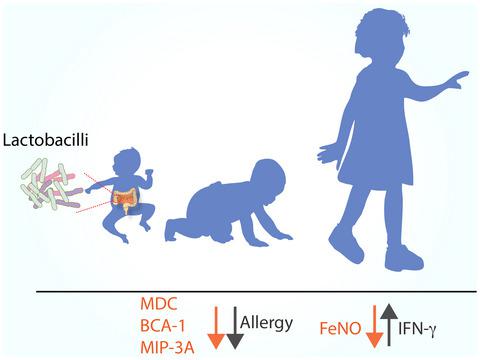当前位置:
X-MOL 学术
›
Clin. Exp. Immunol.
›
论文详情
Our official English website, www.x-mol.net, welcomes your
feedback! (Note: you will need to create a separate account there.)
Childhood allergy is preceded by an absence of gut lactobacilli species and higher levels of atopy-related plasma chemokines.
Clinical & Experimental Immunology ( IF 3.4 ) Pub Date : 2020-07-11 , DOI: 10.1111/cei.13494 S Björkander 1, 2 , C Carvalho-Queiroz 1 , J Hallberg 2, 3, 4 , J-O Persson 5 , M A Johansson 1 , B Nussbaum 1 , M C Jenmalm 6 , C Nilsson 2, 3 , E Sverremark-Ekström 1
Clinical & Experimental Immunology ( IF 3.4 ) Pub Date : 2020-07-11 , DOI: 10.1111/cei.13494 S Björkander 1, 2 , C Carvalho-Queiroz 1 , J Hallberg 2, 3, 4 , J-O Persson 5 , M A Johansson 1 , B Nussbaum 1 , M C Jenmalm 6 , C Nilsson 2, 3 , E Sverremark-Ekström 1
Affiliation

|
Alterations in the composition and reduced diversity of the infant microbiome are associated with allergic disease in children. Further, an altered microbiota is linked to immune dysregulation, including skewing of different T helper (Th) subsets, which is also seen in atopic individuals. The aim of this study was, therefore, to investigate the associations between gut lactobacilli and Th‐related plasma factors in allergy development during childhood. A total of 194 children with known allergy status at 1 year of age were followed to 10 years of age. We used real‐time polymerase chain reaction (PCR) to investigate the presence of three lactobacilli species (Lactobacillus casei, L. paracasei, L. rhamnosus) in infant fecal samples (collected between 1 week and 2 months of age) from a subgroup of children. Plasma chemokines and cytokines were quantified at 6 months and at 1, 2, 5 and 10 years of age with Luminex or enzyme‐linked immunosorbent assay (ELISA). Fractional exhaled nitrogen oxide (FeNO) was measured and spirometry performed at 10 years of age. The data were analysed by non‐parametric testing and a logistic regression model adjusted for parental allergy. An absence of these lactobacilli and higher levels of the chemokines BCA‐1/CXCL13, CCL17/TARC, MIP‐3α/CCL20 and MDC/CCL22 in plasma at 6 months of age preceded allergy development. The presence of lactobacilli associated with lower levels of atopy‐related chemokines during infancy, together with higher levels of interferon (IFN)‐γ and lower FeNO during later childhood. The results indicate that the presence of certain lactobacilli species in the infant gut may influence allergy‐related parameters in the peripheral immune system, and thereby contribute to allergy protection.
中文翻译:

在儿童过敏之前,没有肠道乳杆菌种类和较高水平的特应性相关血浆趋化因子。
婴儿微生物组的组成变化和多样性降低与儿童过敏性疾病有关。此外,改变的微生物群与免疫失调有关,包括不同的T辅助(Th)亚群的倾斜,这也见于特应性个体。因此,本研究的目的是调查童年过敏症发展过程中肠道乳杆菌和Th相关血浆因子之间的关系。1岁以下共有194名已知过敏状态的儿童被随访到10岁。我们使用实时聚合酶链反应(PCR)调查三种乳酸菌种(存在干酪乳杆菌,干酪乳杆菌,鼠李糖乳杆菌)收集自一小组儿童的婴儿粪便样本(年龄在1周至2个月之间)。使用Luminex或酶联免疫吸附测定(ELISA)分别在6个月,1、2、5和10岁时定量血浆趋化因子和细胞因子。测量了呼出的一氧化氮(FeNO),并在10岁时进行了肺活量测定。通过非参数测试和针对父母过敏调整的逻辑回归模型对数据进行了分析。在变态反应发生之前的6个月大时,血浆中缺乏这些乳酸杆菌和较高水平的趋化因子BCA-1 / CXCL13,CCL17 / TARC,MIP-3α/ CCL20和MDC / CCL22。乳杆菌的存在与婴儿期特应性相关趋化因子的水平降低,以及干扰素(IFN)-γ的水平升高和儿童后期的FeNO降低有关。
更新日期:2020-07-11
中文翻译:

在儿童过敏之前,没有肠道乳杆菌种类和较高水平的特应性相关血浆趋化因子。
婴儿微生物组的组成变化和多样性降低与儿童过敏性疾病有关。此外,改变的微生物群与免疫失调有关,包括不同的T辅助(Th)亚群的倾斜,这也见于特应性个体。因此,本研究的目的是调查童年过敏症发展过程中肠道乳杆菌和Th相关血浆因子之间的关系。1岁以下共有194名已知过敏状态的儿童被随访到10岁。我们使用实时聚合酶链反应(PCR)调查三种乳酸菌种(存在干酪乳杆菌,干酪乳杆菌,鼠李糖乳杆菌)收集自一小组儿童的婴儿粪便样本(年龄在1周至2个月之间)。使用Luminex或酶联免疫吸附测定(ELISA)分别在6个月,1、2、5和10岁时定量血浆趋化因子和细胞因子。测量了呼出的一氧化氮(FeNO),并在10岁时进行了肺活量测定。通过非参数测试和针对父母过敏调整的逻辑回归模型对数据进行了分析。在变态反应发生之前的6个月大时,血浆中缺乏这些乳酸杆菌和较高水平的趋化因子BCA-1 / CXCL13,CCL17 / TARC,MIP-3α/ CCL20和MDC / CCL22。乳杆菌的存在与婴儿期特应性相关趋化因子的水平降低,以及干扰素(IFN)-γ的水平升高和儿童后期的FeNO降低有关。











































 京公网安备 11010802027423号
京公网安备 11010802027423号